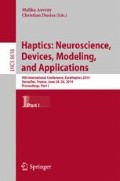Abstract
We introduce the concept of “Modifier Tactile Pattern” as a pattern that modifies the interpretation of other elements that compose a Tacton or an entire tactile message. This concept was inspired by the prefixation strategies of the Braille system. We also show how to design tactile languages applying the concept of Modifier by following methodologies and approaches of Tacton design that already exist in literature. Then a modifier-based tactile language is designed and assessed in a user study.
Access this chapter
Tax calculation will be finalised at checkout
Purchases are for personal use only
References
Brewster, S., Brown, L.M.: Tactons: structured tactile messages for non-visual information display. In: Proceedings of the Fifth Conference on Australasian User Interface, AUIC ’04, vol. 28, pp. 15–23. Australian Computer Society Inc., Darlinghurst (2004)
Enriquez, M., Maclean, K., Chita, C.: Haptic phonemes: basic building blocks of haptic communication. In: Proceedings of 8th International Conference on Multimodal Interfaces (ICMI 2006). ACM Press (2006)
Erp, J.B.V., Veen, H.A.V., Jansen, C., Dobbins, T.: Waypoint navigation with a vibrotactile waist belt. ACM Trans. Appl. Percept. (TAP) 2(2), 106–117 (2005)
Riddle, D.L., Chapman, R.J.: Tactile language design. In: Proceedings of the Human Factors and Ergonomics Society Annual Meeting, pp. 478–482 (2012)
Sherrick, C.: Vibrotactile pattern perception: some findings and applications. In: Heller, M.A., Schiff, W. (eds.) The Psychology of Touch. Lawrence Erlbaum, Hillsdale (1991)
Ternes, D., MacLean, K.E.: Designing large sets of haptic icons with rhythm. In: Ferre, M. (ed.) EuroHaptics 2008. LNCS, vol. 5024, pp. 199–208. Springer, Heidelberg (2008)
van der Linden, J., Johnson, R., Bird, J., Rogers, Y., Schoonderwaldt, E.: Buzzing to play: lessons learned from an in the wild study of real-time vibrotactile feedback. In: Proceedings of the SIGCHI Conference on Human Factors in Computing Systems, CHI ’11, pp. 533–542. ACM, New York (2011)
Acknowledgments
Thanks are due to the people that volunteered for the tests. We also acknowledge CAPES, CNPq-Brazil (305071/2012-2) and AES Sul for the financial support.
Author information
Authors and Affiliations
Corresponding author
Editor information
Editors and Affiliations
Rights and permissions
Copyright information
© 2014 Springer-Verlag Berlin Heidelberg
About this paper
Cite this paper
de J. Oliveira, V.A., Maciel, A. (2014). Introducing the Modifier Tactile Pattern for Vibrotactile Communication. In: Auvray, M., Duriez, C. (eds) Haptics: Neuroscience, Devices, Modeling, and Applications. EuroHaptics 2014. Lecture Notes in Computer Science(), vol 8618. Springer, Berlin, Heidelberg. https://doi.org/10.1007/978-3-662-44193-0_39
Download citation
DOI: https://doi.org/10.1007/978-3-662-44193-0_39
Published:
Publisher Name: Springer, Berlin, Heidelberg
Print ISBN: 978-3-662-44192-3
Online ISBN: 978-3-662-44193-0
eBook Packages: Computer ScienceComputer Science (R0)

